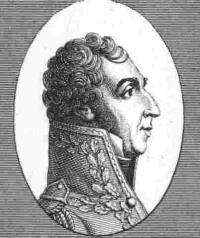Claude Dallemagne facts for kids
Claude Dallemagne (born November 8, 1754 – died June 12, 1813) was a brave French soldier. He started his army career under the old kings of France. He fought in the American Revolutionary War to help America gain independence. Later, he became a high-ranking general during the French Revolutionary Wars. He even fought with Napoleon Bonaparte in Italy in 1796. He continued to serve in the army during the Napoleonic Wars.
Contents
Early Military Life
Claude Dallemagne was born on November 8, 1754. His family lived in Peyrieu, Ain, France. When he was 18, he joined the Hainaut Regiment. He changed his last name to Dallemagne.
In 1777, his army group sailed to the West Indies. He joined Comte d'Estaing's fleet. Dallemagne fought in several battles there. These included fights in Dominica, St. Vincent, Grenada, and St. Lucia. He was hurt during the battle at St. Lucia. In 1779, he also took part in the Siege of Savannah in Georgia. By 1786, he had become a sergeant-major.
The French Revolution and Beyond
Quick Rise in Rank
During the French Revolution, Claude Dallemagne's career moved very fast. He became a second lieutenant in September 1791. By June 1792, he was a lieutenant. Just a few months later, in September, he became a captain.
In late 1793, he fought at the Siege of Toulon. For his bravery, he was promoted to general of brigade. After a short time with the Army of the Western Pyrenees, he moved to the Army of Italy in 1794. That year, he captured the Col de Tende mountain pass. He also served in the 1795 military campaign.
Fighting in Italy
In April 1796, Dallemagne led a brigade in Francois Macquard's division. His troops were sent to the front lines. This happened after the Montenotte Campaign ended. Sardinia-Piedmont had to ask for peace.
Napoleon Bonaparte created a special advance guard. It had 3,500 foot soldiers and 1,500 cavalry. Bonaparte put Dallemagne in charge of this group. They marched along the Po River. Their goal was to get around the Austrian general Johann Beaulieu. Dallemagne's troops crossed the Po River. They defeated the Austrians at the Battle of Fombio in May 1796.
Two days later, he led his soldiers at the Battle of Lodi. This was a big success. Dallemagne, along with other brave generals, helped rally the troops. They crossed a bridge even under heavy cannon fire.
In July, Dallemagne's brigade joined General Masséna's forces. He led his soldiers with great skill at the Battle of Lonato. On July 31, his troops helped take Lonato back from the Austrians. On August 3, the Austrians pushed back his attack on Gavardo. But this action helped Masséna defeat another Austrian brigade. Two days later, Dallemagne fought at the Battle of Castiglione. He was promoted to general of division on August 15.
Dallemagne played important roles during the Siege of Mantua. After some battles, he led an attack on September 24. This pushed the Austrian soldiers back into their fort. During the Battle of Arcole campaign, Dallemagne led a small division. He also commanded a division during the Battle of Rivoli campaign. In the spring of 1797, he led a division in the invasion of Austria.
Later Years and Retirement
After 1797, Dallemagne held commands in different cities. These included Boulogne, Ancona, Rome, and Mainz. He asked to retire from the army in December 1799. His retirement became official in 1802.
He then started a career in politics. He served as a deputy in the Corps législatif. Dallemagne married Jeanne Christine Gaudet in 1800. They had two sons, Clément and Claudius.
Serving the Empire
In 1803, Dallemagne became a Legionnaire in the Légion d'honneur. The next year, he became a Commandant. Emperor Napoleon called him back to active duty in 1807. He commanded a special army group until 1809. He was stationed in Pomerania and Berlin.
From March 1809 to March 1810, he was the governor of Wesel. He also briefly took part in the Walcheren Campaign. From 1810 to 1813, he commanded the military division of Caen. The emperor gave him the title of Baron in March 1813. Claude Dallemagne died in Nemours on June 12, 1813. His name, DALLEMAGNE, is carved on Column 26 of the famous Arc de Triomphe in Paris.
See also
 In Spanish: Claude Dallemagne para niños
In Spanish: Claude Dallemagne para niños


